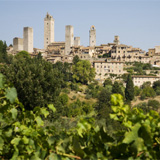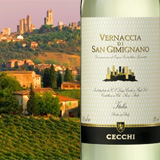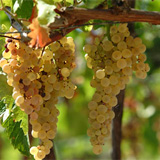Vernaccia is a white Italian wine, made from the Vernaccia grape, produced in and around the Italian hill town of San Gimignano in Tuscany. Since the Renaissance period it has been considered one of Italy's finest white wines. It was the first Italian wine to be awarded DOC status in 1966; then on July 9th, 1993 it was upgraded to DOCG.
The word Vernaccia loosely means common, local or native grape. In fact, the Vernaccia di San Gimignano is a grape strictly connected to the area and cannot be found in any other wine region. Vernaccia di San Gimignano's origins are shrouded in the mists of time, over the centuries the vines have adapted superbly to the soils around San Gimignano.
Internationally, it is probably the least appreciated Tuscan wine, firstly because it is not a red wine and secondly because this indigenous grape is naturally high in acidity and not particularly fragrant. In San Gimignano, the Vernaccia grapes planted in sandstone based vineyards tend to produce the best examples of Vernaccia di San Gimignano. The wine is characteristically dry with crisp acidity and a lively bright finish.
Modern winemaking has introduced the use of oak aging to give the wine another layer of complexity and palate roundness. While very different from the historic style of Vernaccia di San Gimignano, the success of these more modern and international styles is yet to be established. Vernaccia the grape is thought to be a descendant, possibly, of Grechetto, widely used in the wines of Umbria to the south of Tuscany.
There are approx 200 producers of Vernaccia di San Gimignano with a production of about 5.5 million bottles annually. The resulting wines from this dynamic, historic region can vary greatly in flavour from the north to south depending on the terroir. One trait all Vernaccia possesses is a crisp acidity that the painter Michelangelo said, "...kisses, licks, bites, pinches and stings" and a subtle, pleasant, bright finish.










